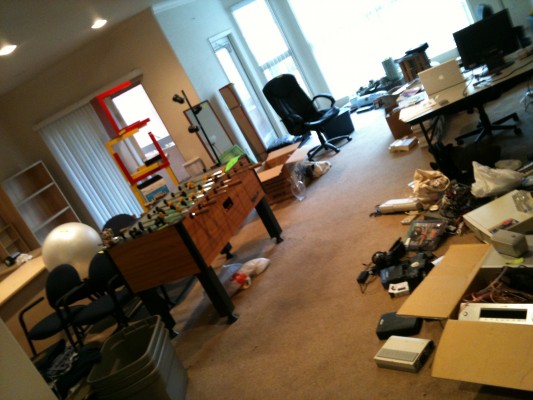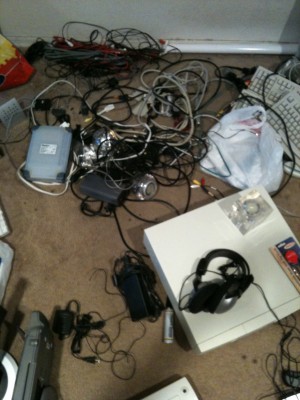I moved offices and residences recently and took advantage of the opportunity to sell off a bunch of stuff. There were a handful of useful lessons that came from this experience and I wanted to post them here for the benefit of anyone else considering hosting a sale.
Maintain a page of thumbnails and post feeder ads

This technique worked really well. The idea is to have every ad you make include a reference to a single page that lets someone quickly browse all your items. Each ad becomes a feeder to this central page so while you might advertise a desk on Craigslist you include a link at the bottom showing the other great stuff you have available. I setup a free Photobucket account and used it to host this page which I kept current with photos and prices of stuff that was still available. It made it really easy to take pics with my phone and populate it with items and remove them as they sold.
Distribution before merchandising

It’s a daunting task when you realize exactly how much stuff you have to get rid of. The temptation is to immediately begin pricing and organizing things. Resist this. All the merchandising in the world is pointless if nobody shows up. Your first order of business should be to get people in the door and worry about the merchandising task only once you have the problem of shoppers.
 The two most effective traffic generation activities for me were making physical signs to get foot traffic and doing the Craigslist ads. For signs I recommend the big bright cardstock at an office supply store, a fat magic marker and taping it to a box that you anchor with rocks. Figure out the closest main traffic arteries and place the signs strategically so they’re visible from both directions and so there’s a sign of the same color visible at every turn until they get there. Start early (6am) – you’d be surprised how many people are up at that hour and looking for yard sales (the majority of my foot traffic came before 10am). There’s seemingly a whole culture of people who drive around looking for these signs and scavenging at yard sales. And that leads to the next point:
The two most effective traffic generation activities for me were making physical signs to get foot traffic and doing the Craigslist ads. For signs I recommend the big bright cardstock at an office supply store, a fat magic marker and taping it to a box that you anchor with rocks. Figure out the closest main traffic arteries and place the signs strategically so they’re visible from both directions and so there’s a sign of the same color visible at every turn until they get there. Start early (6am) – you’d be surprised how many people are up at that hour and looking for yard sales (the majority of my foot traffic came before 10am). There’s seemingly a whole culture of people who drive around looking for these signs and scavenging at yard sales. And that leads to the next point:
For many it’s about the treasure hunt, not the savings

I had the preconception that people go to a yard sales because they can get stuff cheap. What I learned is that a lot of the people are there not for the bargains but for the thrill of the treasure hunt and what they might find. Foot traffic brings the treasure hunters and Craigslist brings the bargain shoppers – you need both. Craigslist will help you clear the major items but if you’re like me then you have all kinds of other random crap that there’s no effective way to advertise but needs to go.
One person’s trash is another person’s treasure

This is essentially a corollary to the above but it deserves its own mention. I had amassed a huge pile of stuff that I was planning to donate to a shelter; stuff that I figured had no chance of selling but that someone might be able to use. On more than one occasion people made offers for things in that pile: old birkenstocks, ratty jeans, kitchen items. What you consider worthless has value for others.
Traffic sources by effectiveness

I asked every visitor how they found the sale. Here’s my best guess at the breakdown of traffic in terms of effectiveness (absolute dollar amount attributed to that traffic source):
In retrospect I should have splurged for the $20 to do an ad in the newspaper but I missed the boat on that.
Phones aren’t just for calling – think SMS

This only happened a few times but a couple people texted me. I had listed my cell phone on the Craigslist ads thinking some would call and the others would email but I learned some people prefer texting. If you list a number make sure to use one that can receive SMS messages.
Time is the key factor

This is an obvious one but it bears mention because it probably is the single biggest determinant of your profit: start the process as early as possible (not early as in the day, early as in a week before if you can). The more time you have the more you can experiment with higher prices and not get pressured into doing bad deals. I started two weeks in advance and tiered the sale into two phases: reasonable mode and firesale mode. As you near the final hour at which you have to be out your prices approach zero (and actually negative because disposal of stuff costs time/$$). Of course there is a point of diminishing returns at which time spent optimizing prices isn’t worth it. But having the more time available allows you to…
Ratchet prices up: establish a floor then raise the roof

Keep a log of all the people that have made offers. A low offer in the beginning may seem like something to ignore but that offer becomes valuable if you haven’t sold the item in the final hours. Also once you have a buyer at a certain price, jack the price on the ads and see if you can do better.
Competing bids and courtesy

So I royally blew a deal where I had a couple firefighters looking at buying all the office furniture. Another guy I had spoken with earlier showed up while we were negotiating price, raced over plunked money in my hand and walked off with the filing cabinet. The firefighters looked at each other and left without saying a word. The lesson there is if you know you have multiple people that are after the same item, make them aware of the fact. Establish a protocol for “first come, first serve.” I should have stopped file cabinet guy and given the firefighters the opportunity to do the deal as they had come first.
Keep power supplies plugged into their devices


This was just pure idiocy on my part but I made a pile of cables and electronics and allowed stuff to get mixed up. In the end I had a massive snarl of cables and devices where it was impossible to find the corresponding power device. Leave things plugged in and tape stuff together so it stays consolidated lest you wind up with this:
Oh and with computers either wipe the hard drive or smash it. The couple bucks you may get from selling it is trivial if it compromises passwords or important personal data.
Anyways, those are my takeaways. Hopefully some of this is useful if you’re looking to do a yard sale. I gotta say there is something extremely satisfying about clearing out a bunch of old items and getting cash for it. And negotiating (when it’s not critical) is actually a lot of fun.







And for the things you can't sell and don't want to drag around, find some good homes.
You can get Goodwill to pick up clothing, and books should go to the public library.
Might also be useful to plan the yard sale close to whenever your city's electronics recycling day is, so you can move it straight there.
Thanks for a great post Sean. I will use your advice this coming weekend.
Tony